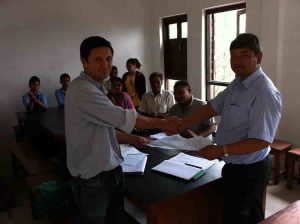In addition to working on SBE (Social Business for Education) projects and tending to SIP needs of our project-site school Raithane in Thangpalkot, Sindhupalchok, one of the other ways COMMITTED seeks to further its Sikchya Mero Adhikar (Education-My Right) campaign is by working with companies in Nepal interested in providing their Corporate Social Responsiblity (CSR) funds to us to carry out education-related projects.
As part of our “Sikchya Mero Adhikar” (Education-My Right) campaign, COMMITTED strives to ensure free and quality education is available to children in communities we serve . Generally, COMMITTED collaborates with communities–through a comprehensive community planning process–to set up Social Business for Education (SBE) projects. In addition to financing education of the children, SBE projects also finance community development projects, address livelihood issues and foster awareness of, and consideration for, the conservation and sustainability of natural resources and environment. We make every effort to use renewable energy and integrated farming/agricultural practices as the basis for social businesses.
NCell agreed to fund a project at Dolagiri Higher Secondary School, Changunarayan, Bhaktapur, following the submission, in early 2013, of detailed project proposal by Jayjeev, the Executive Director of COMMITTED. NCell agreed to provide Rs. 2,700,000 and the school another Rs. 200,000 (totalling approximately US$29,000) to carry out projects that addressed the school’s SIP needs and funded two SBE projects. In this particular case, the SBE would serve the school, making it considerably more sustainable, and not so much the community.
* * * * * * * * *
Dolagiri Higher Secondary School and Their Needs
Dolagiri HSS is located about 5 km to the north-west of Bhaktapur City in Kathmandu valley. The school has a main school building and another building with the core structure, walls, and doors fixed, but awaiting finishing-work.
The project sought to make major improvements to the infrastructure–securing the boundaries, creating a play area, classroom upgrades, building a primary-only toilet wing (the school had just four toilets for the whole school community, all of which were in deplorable conditions), and moving the entrance to a different site for safer and more convenient access to the school buildings. Resource upgrades–specifically for primary school–were also in the plan, including a major upgrade to the existing library.
SBE projects were also envisioned to ensure sustainability of the education program. They would consist of vegetable farming, and establishment and sale of electricity to the local community, generated by solar cells. The two SBE projects would not only generate income for the school, but with student involvement, they would give an opportunity to the students to learn to do hands-on science and acquire transferable practical skills.
* * * * * * * * *
On June 11, 2013, the school management committee and COMMITTED formalised the agreement to carry out the project over the course of the next seven months.

Soon after, implementation of the projects began in earnest. Our resident engineer, Bal, got to work with the construction crew on the boundary wall and the children’s play area. Classroom and library renovation, renovation of old and addition of new bathrooms were also carried out concurrently. (Click here for a photo album showing the progress in the work.)
In the mean time, COMMITTED hired two horticulture experts to conduct an initial evaluation of site and to recommend us on the appropriate vegetables. Three sites were selected for vegetables (adjoining patches of land), flowers (terrace), and fruits (larger land pieces on hilly areas adjoining school property). The students helped complete the work on the fields. They were given hands-on instructions on the process during a follow-up visit from the experts. All the areas were fenced–to secure it from wandering domestic animals–tilled and vegetables planted. (Click here to go to the photo album.)
The second SBE–solar cell back-up electricity–has also been set up and is running. (Click here to go to the photo album.)
By the end of the project, as per NCell stipulation, all but a small fraction of the fund–only about Rs. 150,000 (about US$1500)–will have been invested in the school in the seven-month long project. The reporting cost COMMITTED used from the project budget, at Rs. 150,000, stands just at 5.5%, ensuring that the majority of the funds benefited the school and its students!
